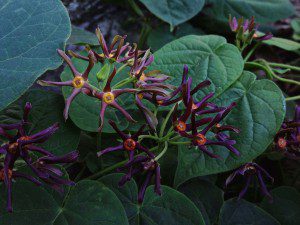Wavyleaf Basketgrass: Help Stop it Now!
Driving into the Nature Conservancy’s Fraser Preserve on a warm July morning is like entering a sanctuary. The hustle and bustle of the Beltways is left behind as I head west on Georgetown Pike, watching the houses get further and further apart. A few more turns and dips and I start wondering if I’m lost.…
Asclepias Tuberosa, the Butterfly Queen
How did such a lovely plant come by so many spurious common names? Poor Asclepias tuberosa. Known by many as butterfly weed, but some of its alternative common names are even worse than that. Pleurisy root, for example. Indigenous peoples once chewed its tough taproot to cure pulmonary ailments, presumably it had a more enticing…
Wild and Wonderful West Virginia: Report from the Field
In a perfect combination rare plants and plant people came together on last month’s VNPS extended field trip to West Virginia. The “flower per hour” crowd enjoyed perfect weather and were very happy taking time to get to know the plants and watch for pollinators, reported Sally Anderson, who was on the trip, and has…
A Boy Named Sue: When and Where to Use a Plant’s Scientific Name
Why is using a plant’s scientific name important? Especially when common (vernacular) plant names can give you so much more information about the thought process and cultural beliefs of the people that named the plants. The use of vernacular in plant naming is a time-honored tradition that should never be thrown out because of what…
Fracking in Virginia: Report from Conservation Chair
VNPS Conservation Chair, Marcia Mabee Bell, attended a workshop on June 24, 2014 presented jointly by the Virginia Conservation Network and the Virginia League of Conservation Voters. Fracking represents huge changes to our state, its economy, and its environmental health; all of Virginia’s citizens need to become informed about this issue. Here is Marcia’s report:…
Matelea obliqua: Climbing Milkweed
Did you know that monarchs are not the only caterpillars that feed exclusively on milkweeds? From our guest blogger and photographer, Fritz Flohr Reynolds: Matelea obliqua, climbing or oblique milkweed, is a perennial herbaceous vine native to the eastern United States. Its range includes Washington D.C., as well as parts of Maryland and Virginia, including…
Native Plants for Pollinators: An App
It’s National Pollinator Week, and now we can all Bee smart, because there’s an app for that! Yes, really. The next time you are shopping for plants, you will be able have help in figuring out the plants you can use in your very own garden to help pollinators the most. Available on both Android…
VNPS Writes Proclamation for Pollinator Week
The VNPS takes an active role in legislative issues, keeping members informed of important ideas and laws that are being considered by lawmakers in Virginia. We also coordinate with other groups to put forward actions that work toward our goal of conservation. Recently the Pollinator Partnership put out a call for national recognition of a…
Dr. Tallamy’s Reply to “What’s all the fuss about native plants?”
Our blog this week is a letter written by Dr. Doug Tallamy, Professor and Chair of the Department of Entomology and Wildlife Ecology at the University of Delaware, and author of Bringing Nature Home. Written to the New York Times last week: Subject: Misinterpretation/factual errors in article on Gardening for Climate Change Dear Editor: I am…

